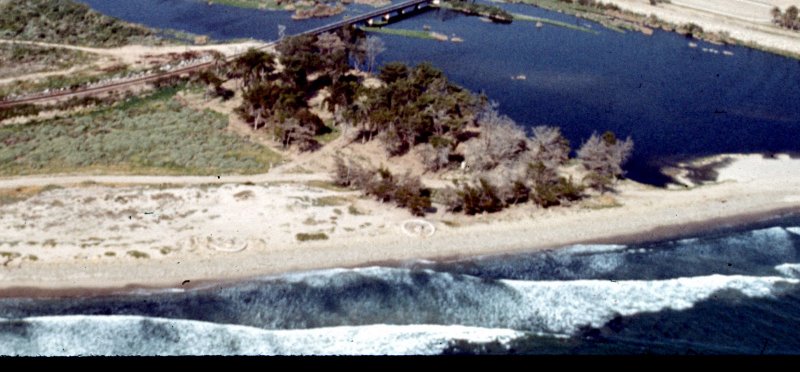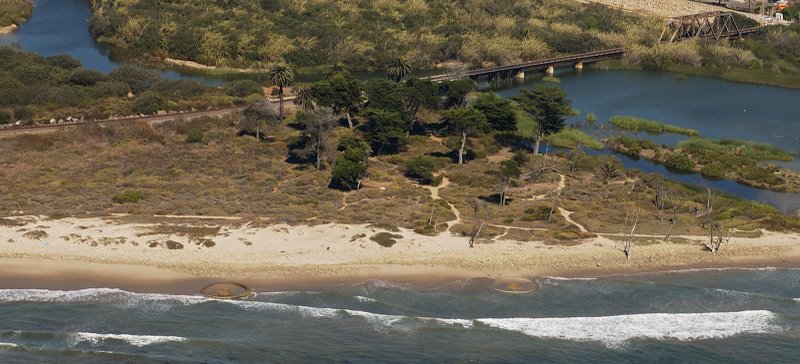Historical Remnants on the beach at Emma Wood State Park
Walking on the beach at Emma Wood State Beach, one comes across two concrete pillars, maybe surrounded by 38 foot concrete rings (depending on the season and the tides) 250 feet apart. What are they?
Rings are visible Rings hidden by sand There is only a small reference to these structures in the Emma Wood State Beach web page "The park also features the crumbling ruins of a World War II coastal artillery site," with no other references about what, where, why and how. Where are these remnants? The next photo shows them back in 1972, when the center support was actually in the center. 1972 Overview -- See the two rings at the bottom of picture, well above the beach ....
In this photo, from 2002, the ocean has eroded more of the beach,
2002 Overview -- See the two rings at the bottom of picture, in the surf line....
Some of the history and details of these structures are described in a brochure from the Californa State Parks and Recreation, which is reproduced below. Also, if you find this site interesting, or you have any comments, please sign the guest book.
The Guns of Ventura© The story of Photo of gun emplacement with men On a windswept
cobble beach near the mouth of the West Coast Attacked! Fear gripped
Americans on the West Coast following the devastating surprise attack by the
Japanese at In late December,
1941, a number of long-range Japanese submarines reached the In the evening
twilight of Monday, February 23, 1942, the Japanese submarine “I-17” surfaced
offshore from the Ellwood oilfield, 12 miles north of Photo of period newspapers Coastal Defense Set Up Photo of searchlight Immediately after
this attack, the 2nd Battalion of the 144th Field
Artillery (California National Guard) was rushed from By October 1942,
the Japanese forces were on the defensive, but the threat of attack along the At what is now the
Ventura County Fairgrounds the Regiment set up “Long Toms” Arrive In contrast to the
World-War-I vintage guns used earlier, the 56th Regiment was
equipped with the much improved “Long Tom” guns which could fire a 95 –pound
projectile 14 miles! The accurate firing
of these large guns required careful coordination. Spotters at two separate observation posts
(one at Grant park above Photo of Long Tom, with crew on a Kelly
base (it looks like) GIs Dig In The GIs quickly made Map of Battery Two Site More precise map of Battery Two Site By January, 1944,
the threat of enemy attack to the west Coast was gone and Still it is
possible to stand on this site and imagine those early days of World War II
when the future held so much fear and uncertainty for Americans, and when the GIs of
PRESERVE YOUR HERITAGE! This historic site is
protected within the boundaries of The California
Department of Parks and Recreation gratefully acknowledges the invaluable
contribution of Mr. Jason Marmor for his research of Funding for this
brochure provided by the CHANNEL COAST NATURAL HISTORY ASSOCIATION. All rights reserved. Photos from National Archives. Last updated 9 February 2008 Using the above map, I walked the area. I did not see any scattered asphalt, but I did see some bricks and concrete in the ground. At first I thought it could be the foundation of the ammunition magazine (referenced as item 11 in the above map), but Jason Marmor corrected my assumption -- it's in the wrong place, and it's not what the foundation looks like. But here's a photo anyhow: Try using the Open Directory Project to search for other stuff.



Copyright (C) 2002-2007 Kenneth & Gabrielle Adelman, California Coastal Records Project,
www.Californiacoastline.org
and the center support is no longer centered.

Copyright (C) 2002-2007 Kenneth & Gabrielle Adelman, California Coastal Records Project,
www.Californiacoastline.org

View My Guestbook
Sign My Guestbook






Prologue (should be Epilogue)
California Department of Parks and Recreation and the City of
valuable part of your heritage and are protected by state and
federal law. Please do not remove or
disturb any artifacts.
Reports acts of vandalism to a Park Ranger or Camp host.


Comments about web page format
should be sent to Don

It uses human editors to intelligently add to their data base of web sites.